Bridging the gap
Reaction Processed Ceramic (RPC 24/8) bridges the gap that lays between steel and ultra-hard engineered ceramics offering a truly unique and unparalleled degree of flexibility that enables tools and components to be selectively coated with a pure ceramic material to provide a level of performance that not only rivals that of a monolithic ceramic, but in many cases exceeds their capabilities on multiple levels.
Whereas solid ceramics offer high hardness, high temperature capabilities, and excellent corrosion resistant properties, the limitations of their forming process, inherent brittle structure and cost prohibitive prices has limited their use as a mainstream engineering material.

Stainless steel ring featuring a ceramic surface.
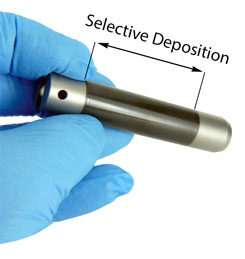
Protection where it matters
With wear limited to the exposed working surfaces of a tool or component, the body merely acts as a structural carrier giving little, if any, reason to have the same ultra-hard wear resistant properties throughout the entire core equally as much as it does on its outer faces.
Reaction Processed Ceramic (RPC 24/8) protects selectively coated surfaces from the extremes of wear and corrosion at elevated temperatures, whilst benefiting from the self-same method of manufacture and structural support of the underlying part, and unlike monolithic ceramic bodies, RPC 24/8 coated faces can withstand mechanical and thermal shock-loading without risk of fracture.

Variable flexibility
There’s never a ‘one size fits all’ material that fulfills the need of every application, and an enhancement of one property is usually at expense of another. Reaction Processed Ceramic (RPC 24/8) provides the best of all worlds: high hardness, high strength, electrical insulation and impact resistance. Furthermore, the constituents of RPC 24/8 can be changed to suit the application in question making it an ‘engineered’ ceramic in its true sense.
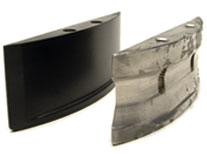
Superior sliding/rotational wear resistance
The carefully engineered structure and extreme levels of hardness enables RPC 24/8 to provide outstanding wear resistance characteristics in applications exposed to sliding, reciprocating and rotational motion. Such benefits often extends the performance of the original tool or component by multiple factors.
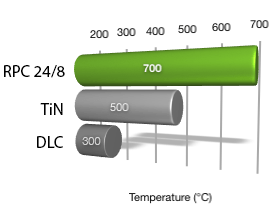
High temperature capabilities
With no binders limiting its performance, RPC 24/8’s pure ceramic, low temperature synthesized structure enables it to operate at elevated temperatures in excess of 700°C, with no loss of hardness or risk of oxidation.

Not just a mechanical bond
One of the keys to the successful functioning of any coating is its ability to bond to the substrate material. Whereas other ceramic coatings rely on a mechanical or ‘encrusted’ bond, the RPC 24/8 process generates a thermo-chemical reaction at the substrate to coating interface, creating a highly cohesive metal-ceramic structure that results in bond strengths exceeding 10,000 psi (69 MPa).
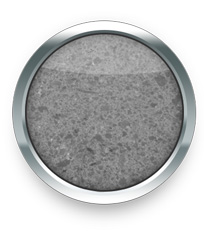
Fully dense, pore-free nanostructure
A material's success is not based on its properties alone, but the structure of its elements plays an equal and vital role in its ability to perform. Reaction Processed Ceramic's nano-particle, pore free structure offers a non-shrinkable, high integrity thermally stable surface that facilitates the ability to be ground, lapped, honed and polished to high dimensional tolerances and surface finishes making it ideally suited as a sealing surface.
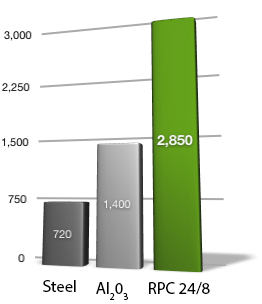
Twice as hard as alumina
Over the years the development of materials technology has played a vital step in improving the life and performance of tools and components, with tungsten carbide replacing tool steels in high wear applications, and monolithic ceramics, where usable, taking it one step further.
In many instances the use of these alternative materials are based on their increased levels of hardness. However, at 2,850 HV, Reaction Processed Ceramic is almost four times harder than tool steel, twice as hard as alumina (even harder than tungsten carbide) and with the ability to add materials such as Silicon Carbide (SiC) and Boron Carbide (B4C) into the RPC matrix, hardness levels exceed that of most advanced engineered ceramics.
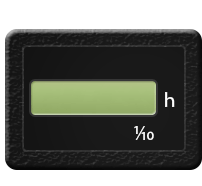
3,000 hours and counting
Corrosive environments can quickly reduce even the hardest of metals to a near useless material if it is incapable of withstanding corrosive attack. The two major factors to overcoming corrosion are inertness, and in coating terms, providing an impermeable barrier to stop the corrosive media attacking the substrate material.
Reaction Processed Ceramic (RPC 24/8) with its fully dense and inert ceramic structure provides corrosion resistance in the most hostile of environments and can surpass more than 3,000 hours under salt spray conditions by comparison to hard chrome plate which showed corrosion of the substrate within 24 hours under the same test conditions.

The inside story
RPC 24/8’s unique ability to coat both external surfaces and internal voids, including the inside diameter of long tubes with small bores, truly sets it aside from any other ceramic coating technology that rely on a ‘line of sight’ or near perpendicular access. Reaction Processed Ceramic can be coated onto surfaces that coatings such as flame sprayed, plasma sprayed and High Velocity Oxy-Fuel (HVOF) coatings cannot reach.
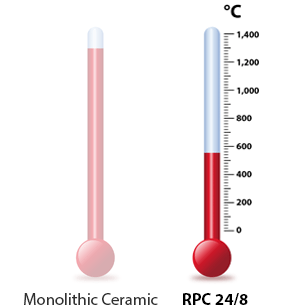
40% of the sintering temperature
A material’s integrity often arises from fusing its particles and molecules at a particular process temperature in order to provide a uniform and cohesive structure. In many instances high fired monolithic ceramics are exposed to sintering temperatures in excess of 1,200 – 1,400°C, resulting in shrinkages of up to 20%.
At less than 600°C, Reaction Processed Ceramic's (RPC 24/8) reactive process temperature results in highly co-adhered, high integrity structures with excellent coating to substrate bond strength.
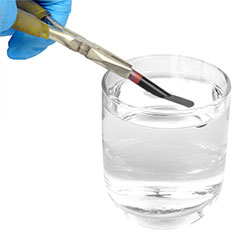
Shocking... but true
Under high thermal cyclic conditions, internal stresses formed within solid ceramic materials can lead to premature failure caused by craze-cracked and spalled surfaces, or in worst case situations, a complete fracture due to excessive thermal shock failure.
RPC 24/8 coated surfaces enable the heat and induced stresses to be dissipated by the underlying metallic component, providing excellent resistance to high thermal cycling and thermal shock failure.
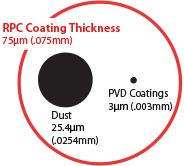
25 times thicker than PVD coatings
At 75µm in thickness, RPC 24/8 provides a protective wear resistant surface that is 25 times thicker than a typical 3µm thick PVD coating such as TiN, CrN and DLC.
A new opportunity awaits
Of course monolithic engineered ceramics will always play a vital role in a variety of applications, however, with selectable deposition and advanced material properties RPC 24/8 not only bridges the elusive gap that has lain between steel and ceramics for many-a-year, but now enables the real possibility for metal tools and components to operate to a level of performance that was previously limited to a chosen few.
Learn more:
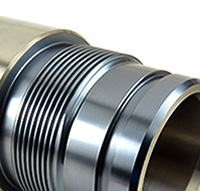 Coatings
Innovative surface coatings based on diamond, ceramics, composites and solid lubrication films.
Coatings
Innovative surface coatings based on diamond, ceramics, composites and solid lubrication films. Applications
Bearings, gears, tooling, splines, threads, punches, dies, leadscrews... discover your limitless potential.
Applications
Bearings, gears, tooling, splines, threads, punches, dies, leadscrews... discover your limitless potential.
 Industries
Aerospace, motorsport, stamping, medical, vacuum, plastic moulding, sciences and many more available.
Industries
Aerospace, motorsport, stamping, medical, vacuum, plastic moulding, sciences and many more available. Contact
Contact our engineers to see how Refmet can provide a solution to your wear and friction issues.
Contact
Contact our engineers to see how Refmet can provide a solution to your wear and friction issues.



